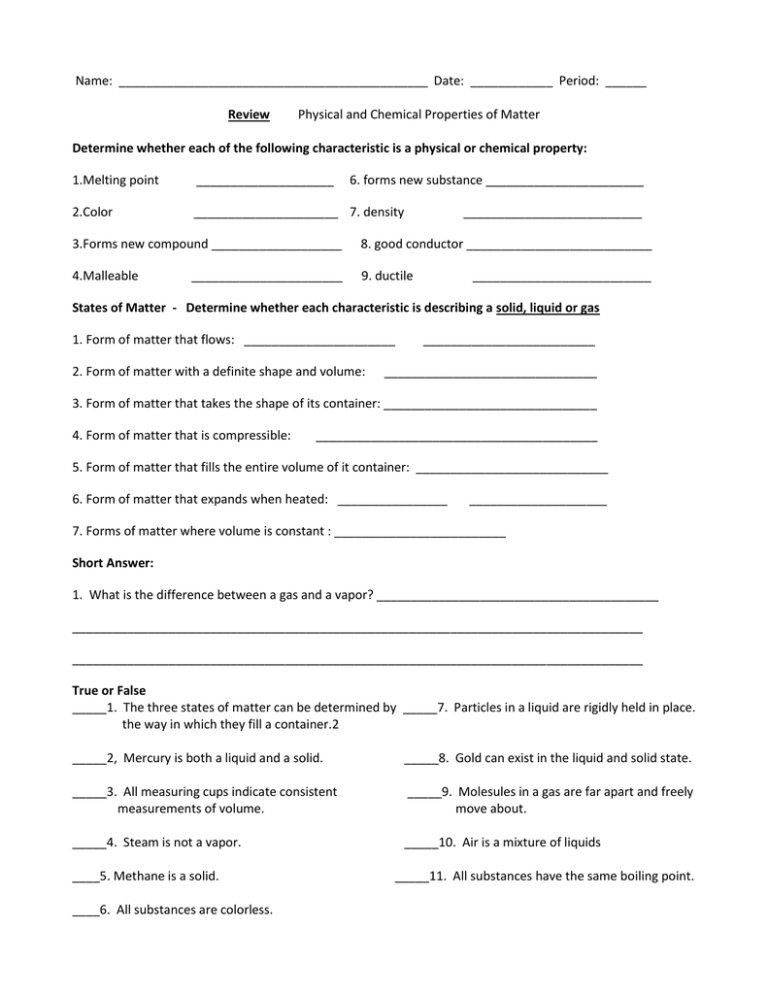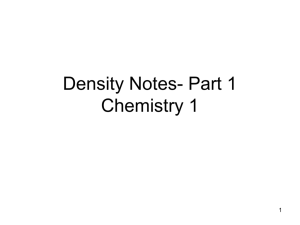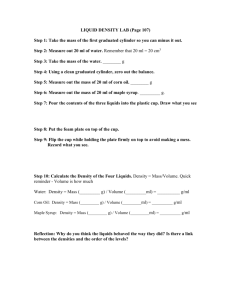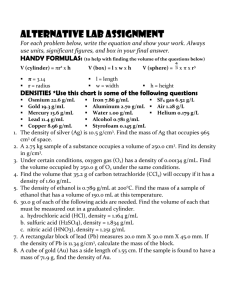Name: Date: ______ Period: ______ Review Physical and
advertisement

Name: _____________________________________________ Date: ____________ Period: ______ Review Physical and Chemical Properties of Matter Determine whether each of the following characteristic is a physical or chemical property: 1.Melting point ____________________ 6. forms new substance _______________________ 2.Color _____________________ 7. density __________________________ 3.Forms new compound ___________________ 8. good conductor ___________________________ 4.Malleable 9. ductile ______________________ __________________________ States of Matter - Determine whether each characteristic is describing a solid, liquid or gas 1. Form of matter that flows: ______________________ 2. Form of matter with a definite shape and volume: _________________________ _______________________________ 3. Form of matter that takes the shape of its container: _______________________________ 4. Form of matter that is compressible: _________________________________________ 5. Form of matter that fills the entire volume of it container: ____________________________ 6. Form of matter that expands when heated: ________________ ____________________ 7. Forms of matter where volume is constant : _________________________ Short Answer: 1. What is the difference between a gas and a vapor? _________________________________________ ___________________________________________________________________________________ ___________________________________________________________________________________ True or False _____1. The three states of matter can be determined by _____7. Particles in a liquid are rigidly held in place. the way in which they fill a container.2 _____2, Mercury is both a liquid and a solid. _____8. Gold can exist in the liquid and solid state. _____3. All measuring cups indicate consistent measurements of volume. _____9. Molesules in a gas are far apart and freely move about. _____4. Steam is not a vapor. _____10. Air is a mixture of liquids ____5. Methane is a solid. ____6. All substances are colorless. _____11. All substances have the same boiling point. Physical or Chemical Change The following actions denote a physical or chemical change: 1. tarnish _____________________ 10. crumble _____________________ 2. tear ________________________ 11. crush _______________________ 3. burn ________________________ 12. Turning grapes into wine (fermentation) _______________ 4. corrode ______________________ 13. rust ________________________ 6. split _________________________ 14. oxidize ______________________ 7. cutting a diamond _____________________________________ 8. Statue of Liberty turning green ___________________________________ 9. water freezing or boiling________________________________________________ Building Vocabulary – Define each word malleable - ___________________________________________________________________________ conductor - ___________________________________________________________________________ density - _____________________________________________________________________________ volatile - _____________________________________________________________________________ meniscus - ____________________________________________________________________________ The Density of Matter 1. The formula for measuring density is : 2. What equivalency is used regarding mL and cm3 when measuring density? 3. Based on the given densities for aluminum, iron and lead, which metal is the less dense? Which metal is most dense? 4. An irregularly shaped stone was lowered into a graduated cylinder holding a volume of water equal to 2.0mL. The height of the water rose to 7.0mL. If the mass of the stone was 25g, what was its density? SHOW ALL WORK!! 5. A sample of iron has the dimensions of 2cm x 3 cm x 2cm. If the mass of this rectangular shaped object is 94g, what is the density of iron? SHOW ALL WORK Properties of Gases 1. Explain the tests used to identify the following gases: a. Hydrogen b. carbon dioxide c. oxygen Lab Knowledge 1. What instrument is used for measuring the volume of liquids? ___________________ 2. What instrument is used for measuring the mass of solids? _____________________ 3. In lab, I calculated the density of the aluminum cylinder to be 2.9 g/cm3 but the actual density of aluminum is 2.7g/cm3. What is the % error in my data? SHOW ALL WORK including the formula for calculating % error. 4. When working with acids, how do you safely combine acid and water? 5. How do you prevent contamination of fluids when measuring liquids in the lab? 6. How do you read the measurement of liquids in a graduated cylinder? 7. What is the difference between a Florence flask and an Erlenmeyer flask? 8. What must be included in a good scientific conclusion?







